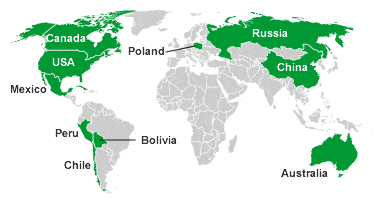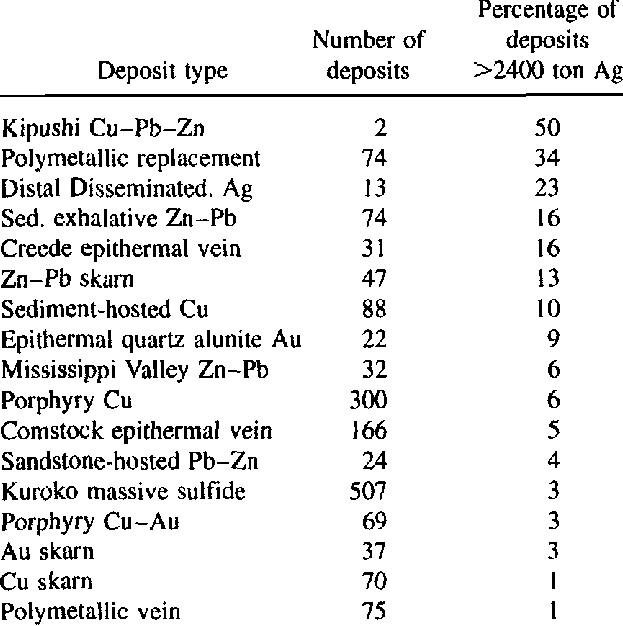Silver Ore Type and Mineral Deposit in the World
Abstract
The world mineral resources of silver ores are mainly located in Russia, Mexico, Canada, USA, Australia and Peru. major silver deposits can be grouped as following types: (1) epithermal vein silver, related to the Mesozoic and Cenozoic volcanic ore and subvolcanic rocks, (2) porphyry silver type; (3) silver bearing massive sulfide deposit in volcanic rocks; (4) sedimentary type silver bearing polymetallic deposit; (5) sedimentary remoulded type silver bearing polymetallic deposit in carbonate rocks.
According to the figures published by the United States Bureau of Mines in 2010, the amount of silver deposits in the world boundary is about 243,540 tons. The source of silver ore is mainly distributed in the Russia, Mexico, Canada, the United States, Australia and Peru, account for about 81% of the total reserves of silver mines in the world. As for the ore types, about two-thirds of silver reserves come from copper, lead and zinc deposits, and one-third of silver comes from independent silver deposits.
Zinc deposits are the most important source of silver. The US Bureau of Mines has analyzed the main silver possess countries, found that about 45% of silver comes from zinc deposits, silver grade around 1.1-330g/t. The independent silver deposit is the second largest source of the silver mineral, about 1 / 3 of the silver deposits come from independent silver deposits.
The silver-bearing copper deposit is the third largest source of silver, its amount accounts for 33% of the total recoverable silver in the United States, 31% in Peru and 28% in Canada. In addition, Chile, Argentina, Panama, Papua New Guinea, Philbin, Yugoslavia, Poland and other countries almost all recover silver from copper deposits. Generally, the silver grade of this type of deposit is lower than 50g/t.
In silver-bearing lead deposits and silver bearing gold deposits, the amount of coverable silver is the least, and the grade is low. This type of deposit mainly in South Africa, Chile. To know more mineral processing plants
2 Main silver production countries
Russia, Mexico, Canada, the United States, Australia, and Peru, account for about 70 percent of the world’s total annual production.
Russia
The silver reserves in Russia about 43,540 t, accounting for 17.8 of the total silver reserves in the world, ranking first in the world. the silver mostly comes from nonferrous metal and precious metal mine.
Mexico
Silver reserves about 42,607 tons, accounting for 17.5% of the world’s total silver reserves, ranking 2nd in the world. According to an analysis report, 46% of silver is from the independent silver deposit, 38% from the lead-zinc deposit and 16% from the copper deposit.
Canada
Silver reserves of 36,076 tons, accounting for 14.5% of the world’s total reserves, ranking in the 3rd place of the world boundary.75% in the lead-zinc deposit, 25% in the copper deposit.
USA
The silver reserve about 28,612 t, accounting for about 11% of the total silver reserves in the world. About 37% silver is produced from the independent silver deposit, 33% from the copper deposit, and 2% from the lead-zinc deposit.
Australia
Silver reserves of 24,258t, accounting for 10% in the total reserves, 95% of silver deposits exist in lead-zinc deposits, and mainly distributed in New South Wales, Queensland and Kalguri.
Peru
The reserves of 21,148t, accounting for about 8.5% of the world’s total silver reserves, mainly distributed in the central and southern Andean veins. Silver mainly occurs in independent silver deposits (about 36% of total reserves), copper-lead-zinc polymetallic deposits (59%) and porphyry copper deposits. Peru is the 2nd largest silver exporter in the world, second only to Mexico.
In summary, the silver reserves in American continent account for 1/2 of the total silver reserves in the world, particularly in the north of the United States, accounting for about 45%. Europe accounts for about 30% of the world’s silver reserves, followed by Oceania. Silver resources are very poor in Asia and Africa.
3 Main silver mineral deposits
- Epithermal vein silver, related to the Mesozoic and Cenozoic volcanic ore and subvolcanic rocks
It is mainly distributed in the circle Pacific silver metallogenic zone, of which Mexico, Bolivia and the western United States are the richest, followed by the Mediterranean region of Europe, Japan and the eastern part of China. Mostly occur in the calc-alkaline volcanic rocks, latite, andrite and volcanoclastic rocks. main components include quartz, calcite, sericite, iron pyrite, pyroxene, gold silver ore and so on.Take Yoltita vein-like silver-gold deposit( Mexico) as the example
Silver output: higher than 10,000t
Gold output: higher than 200t
Grade of silver up to 600g/t
Vein deposit composition: andesite, rhyolite, andesite-tuff and volcanic breccia.
Mineralization stage
In the first stage start forming crystalline and microcrystalline quartz, fine pyrite, coarse-grain zinc blende and fine grain copper pyrite, the content of silver less than 125ppm, gold less than 1ppm. In the second stage, gold and silver mineralization accompany with a small amount of Pb, Zn, Cu has been strengthened, the grade reached the industrial level. Finally, a large amount of quartz being forming. - Porphyrite type of silver mineral
Porphyrite type silver ore mainly distribute in the volcanic zone of North and Latin America, silver mineralization is closely related to the volcanic intrusive rock, and silver is form concentrated in the contact zone between the top of the porphyry uplift and the upper igneous rocks and other rocks.
Compared with similar rocks, the Porphyrite type silver mineral has a higher content of SiO2, K2O, K2O> Na20, and belongs to K-rich rocks. Moreover, with the increase of depth, the value of Ag/Au in the ore increases.For instance
AG-Au ore deposit of porphyry type in the United States of America
location: Mount Ovich, western Idaho
Silver reserves: 1,650t
Grade of silver: 129g/t
The silver ore is disseminated in veinlets, and concentrate in the quartz veins and silicified rhyolite-porphyry. - Sedimentary type polymetallic ore deposit
The deposit occurs in the fracture zone of the geosynclinal or back-arc continental shelf and is controlled by lithology. The ore-bearing rocks include shale, siltstone, dolomitic sedimentary rocks and so on. Most of its ages are Proterozoic and Paleo era. This type of deposit is main in the form of disseminated, banded, lamellar.For instance – Reddog silver-lead-zinc deposit
location: Drang, Mt., west of the Brynx Mountains, northwest of Alaska.
Silver reserves: 6500t
Grade of silver: 82g/t
Rocks: distribute in the shale, argillaceous rock and Firestone. - Sedimentary silver-bearing polymetallic ore deposits in carbonate rocks
It is mostly distributed in North America and Central Europe, the silver grade is about 60g/t.
At general, this type of silver bearing ore occurs at the margin of the large basin or the ridge of anticlinal, is often controlled by a fault induced by basement faults or dissolution. - Volcanic rock type silver deposit
The silver grade of this type is low, but the reserves are very large, about half of the silver produced in the world comes from such deposits.For instance – silver zinc copper deposit
Location: Northeast of Kidd Town, Cochran District, Ontario
Silver reserves: 15,000t
Grade of silver: 134g/t
Concentrate on the felsic and ferromagnesian volcanic rocks
In addition to the above-mentioned deposits, the associated silver in the copper-nickel sulfide deposits, the skarn type silver deposit have also attracted people’s attention.


